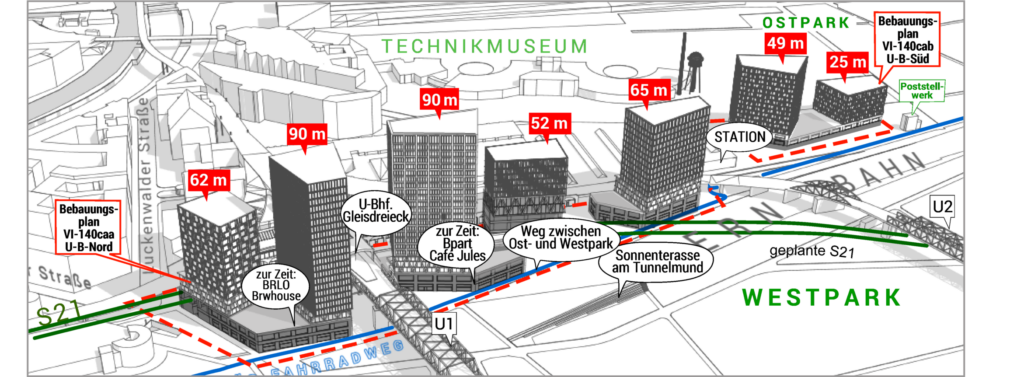No High-rise Buildings in the Park. Stop “Urbane Mitte”!

Why We Are Against Seven Office Towers in Gleisdreieck Park
Taller than the park is wide – the western half of Gleisdreieck Park!
The Urbane Mitte is a building project on the eastern edge of the Westpark, the western half Gleisdreick Park. The name “Urbane Mitte” (Urban Center) is as confusing as the project itself is controversial. Two of the seven towers in planning are 90 meters high and located directly on the Westpark’s eastern edge. 90 meters height is higher than the park is wide in this section, which would degrade the park to a “front yard” for an ensemble of office towers.
What does urban mean?
A peaceful gathering of people of all ages and backgrounds – exactly what has been taking place for more than ten years at Gleisdreieck Park, is now coming under threat by high rise towers. High rise structures block out available light (shadowing), create downdrafts in nearby areas, and reduce available green spaces through soil sealing, contributing to hotter and drier climatic conditions.
Exaggerated building mass
The planning calls for seven high rise towers standing on wide concrete platforms. A total floor area of 119,000 square meters matches that of nearby Potsdamer Platz and is a larger area than was envisioned in the original municipal agreement from 2005. In 2015 the investors were satisfied with a floor area of 100,00 m2, but after the development plan was made public in 2016 the floor area had suddenly increased to 119,000 m2. Who was responsible for this?
No living space! Only commercial and office spaces planned
The investors’ plan calls for 70% office and 30% commercial space. Does Berlin really need more office space? Or more shopping malls? Gleisdreieck Park was a success with the public from the beginning, before the appearance of any commercial spaces at the park’s borders. Even more commercial space is a complete waste. What Berlin needs is affordable living space.
Urbane Mitte / Climate Killer
Parking garages, the structural core of the high-rise towers, are not possible without the use of reinforced concrete. 100,000 tons of CO2 would be released into the environment for a building project that no one needs or wants. The “Urbane Mitte” towers are an ecological disaster, not just for the local environment.
The park’s ecological function
Gleisdreieck Park was financed and built as compensation for the high rise buildings erected on Potsdamer and Leipziger Platz. An ecological assessment at the time describes Gleisdreieck’s function as a fresh air corridor between the Tiergarten and southern edge of the city, a function which would be disrupted by the “Urbane Mitte”.
Everything above board with the climate and wind comfort study?
Studies made of the development plan, commissioned and financed by the investors themselves, contain serious flaws. The climate and wind comfort study takes into account neighboring buildings, but uses 1980 as a reference date, failing to take into account any development since then. Every recent building project, from Yorckdreieck through Dennewitz- and Flottwellstrasse up to Potsdamer Platz are left out of the study. Yet despite these omissions, the study concludes that the wind comfort in the park to the west of the high rises does not meet the standard for wind comfort criteria.
“This is due to the arrangement and relatively tall height of the planned buildings and can be seen and typical for such a development”.
GEO-NET Windcomfort Study, Umweltconsulting GMBH from October 2018, on the development plan Urbane Mitte, Vl-140cab
Severe shadowing
The wooden terraces above the train tunnel entrance are a popular meeting point for people in the Westpark and would be shaded by the new buildings during midday. The development plan’s ecological impact study considers this inconsequential. On closer examination, this is not the case. The following areas would be subject to shading at various times of day – parts of Pohlstrasse and Kurfürstenstrasse, the wooded area next to Anhalter Bahnhof, the area south of the Tempodrom, the bend at Bulowstrasse (Bülowbogen), Nelly-Sachs-Park, the eastern facing part of Dennewitzstrasse, Café Eule, the Technik Museum Park, and the northern side of the Ostpark . . .
The high-rise phalanx’s psychological effect
The psychological effect of high-rise buildings, aside from adverse climate and wind conditions, should not be underestimated. A new wall of towers bordering the park’s edge will be cause for unease among many visitors.
Acclaimed architect Meinhard Gerkan in an interview with Deutschlandfunk radion station:
“I feel the same as most other people do, one feels cramped and penned in – if high rises and resulting air currents are not fully studied and taken into account, there are going to be heightened wind speeds; there is going to be a draft wherever you stand.”
Link to the Deutschlandfunk radio station interview from 2014
First the clear cut, then the impact study!
This was the investors’ motto regarding nature and wildlife preservation. During the winter of 2014/2015 the former wooded tract of land was completely deforested, leaving behind a clear-cut space for assessors to conduct their ecological impact study in 2017. More information on this at gleisdreieck-blog.de
Gridlock pre-ordained?
According to the development plan’s traffic impact study, neighboring streets Schöneberger and Luckenwalder Strasse are sufficient to accommodate the increase in traffic to the five high rises in the northern building area. The two high rises in the southern building area would be accessed via Trebinner Strasse. However, the traffic study assumes no double-parking will take place on any street, an unrealistic assessment, not only because of their location in the Kreuzberg district. The Blog link “Chaos am Gleisdreieck” provides a real-life portrayal of traffic on these streets.
An historic facade disfigured
Gleisdreieck underground station and its neighboring steel viaduct are key elements in the landscape of Gleisdreick’s Westpark, both historic structures which would barely be visible behind high rise towers on their platforms.
In 2015, the Historic Landmarks Office (Landesdenkmalamt) and local preservationists refused to take part in the architectural competition’s jury review for “Urbane Mitte”, stating that competition requirements left no room for an historically appropriate development of the location.
The investors’ statement from the Development Plan Urbane Mitte Vl-140cab argues as follows:
It should be noted that the side of Gleisdreieck station facing west is the rear side of the station, railway property formerly used for freight transport. This side is not representative.
This argument ignores the fact that Gleisdreieck Station and the viaduct are not designated as landmarks for being “representative”, but because of their impressive construction which is only visible from the former railway property to the west of the station, i.e., today’s Westpark.
The following quote from a description of Gleisdreieck station from the data base of the Historic Landmarks Office:
The lofty heights of sections of Gleisdreieck elevated station are an impressive transport construction…
100% Sealing
At the time, the former railway property was covered with track gravel and not sealed. The plan now calls for sealing the surface with a two-story parking garage – resulting in severe consequences for the local climate.
Where does all the rainwater go?
As of now the plan is to divert surface runoff into the mixed-water sewage system underneath streets along the Landwehrkanal. However, strong rains can cause the mixed-water sewage system to run over. Untreated wastewater (rainwater + contaminated surface runoff + industrial wastewater) would flow into the nearby Landwehrkanal – a toxic mix for the fish population.
Towering glass facades – deadly for birds
Milions of bird die yearly from flying into glass surfaces on high rises! At Gleisdreieck as well?
Location unsuitable for high rise development
According to city building guidelines, a high-rise location must be situated directly on a main artery, must be designated from the city as a centrally located point, must not adversely affect ecological or historic building preservation, and must contain a mixed use of at least 30% living space. None of these is the case here.
Safety issues
Development plans for the “Urbane Mitte” encompasses a mix of seven high-rise towers, three underground train lines, one city train line and two train stations, all located along a narrow area with access only from two sides. Such a complex set of factors pushes the boundaries of the building code in favor of maximizing profits – a complexity which calls for additional care and caution when planning internal and access to the site, especially with regards to catastrophe management. The current planning does not meet these standards.
External site access is only possible via small roads to the north and the south, running only to the edge of the site. Internal site access is not possible through public streets. The development plan draft contains no mention in the internal planning area of potential space for use during evacuation of the high rises and train stations.
The driving force – land speculation
In 2014 the current investor purchased the property from the CA Immo/Vivico group for €7.8 million. In the fall of 2020, shortly before the development plan’s second release for public inspection, the “Urbane Mitte” was transferred to Luxemburg as part of a share deal. The property’s market value in the contract was assessed at €162 million. The subsequent owner name became Urbane Mitte Besitz S.à.r.l. The sale itself was financed through funds from the DLE (Deutsche Landentwicklung), who informed investors that the project’s market value was now €204 million. The Berlin land registry office, however, lists a market value of €11.3 million (presumably a sum originally given for tax reasons). The actual amount of money transferred to the UMB Beteiligungs GmbH and the TST Invest GmbH in Luxemburg was €142.5 million, with 11% remaining in possession of the Urbane Mitte Besitz S.à.r.l. A record of this transfer can be found in the Bundesanzeiger where both companies have registered their balances.
